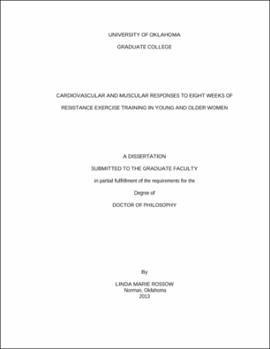| dc.description.abstract | PURPOSE: Resistance training is recommended for all adults of both sexes. The time-course of muscle hypertrophy in young and older women and the arterial stiffness and limb blood flow responses to resistance exercise in young and older women remain to be elucidated. The purpose of this study was to examine the time-course of muscle hypertrophy in young and older women following high-intensity resistance exercise training as well as to examine arterial stiffness and blood flow responses in young and older women to high-intensity resistance exercise training. METHODS: Young (aged 18-25) and older (aged 50-64) women performed full-body high-intensity resistance exercise three times per week for eight weeks. This exercise was performed on six different exercise machines: leg press, chest press, leg extension, shoulder press, leg curl, and lat pull-down. Exercises were alternated so that two lower body exercises or two upper body exercises were never performed together. As the exercise program was meant to be of a high-intensity, subjects began lifting at 80% of their one repetition maximum and training progressed by having subjects perform three sets with ten repetitions performed in the first two sets and the last set being performed to "failure" which was defined as the inability to complete another repetition with good form. All exercise was supervised and performed in the laboratory. At two time points approximately three weeks apart, prior to training, measurements were performed as a control period and no exercise was performed between these measurements. A single post-testing measurement was performed following training. At these three measurement time-points, the following measurements were performed: ultrasound muscle and fat thicknesses at eight body sites (50% and 70% thigh and hamstring, subscapular, chest, deltoid, and -fat only- visceral), thigh circumference, four 50% thigh skin-folds (anterior, posterior, lateral, and medial), whole body dual energy x-ray absorptiometry, carotid to femoral and femoral to tibialis posterior pulse wave velocity, blood pressure, heart rate, resting forearm blood flow, forearm reactive hyperemia, and two functional assessments (an upper and a lower body questionnaire) were performed. Additionally, once every week, the aforementioned ultrasound assessments of muscle and fat at seven and eight sites (respectively), thigh circumference assessment, and four thigh skinfolds were performed. Also, once every two weeks, strength was assessed on each machine by one repetition maximum. Upper body strength was assessed on the second training day of the week and lower body strength was assessed on the third training day of the week. Data was analyzed with ANOVAs and post-hoc t-tests. Alpha was set at p<0.05. Pre values were averaged and the average was used for subsequent analysis if no difference between these values was found. RESULTS: Muscle thickness for all muscles, except at the subscapular site, was found to increase significantly (p<0.05) over time. The first increase in muscle thickness was seen at the 50% quadriceps, 50% hamstrings, 70% hamstrings, and deltoid sites followed by the 70% quadriceps and chest sites. Group differences (p<0.05) were found for the 70% hamstring site only. Carotid-femoral pulse wave velocity showed a significant (p<0.05) group effect only with older subjects having a higher carotid-femoral pulse wave velocity than younger subjects. No significant (p<0.05) effects were found for femoral-tibialis posterior pulse wave velocity or for resting forearm blood flow. A significant (p<0.05) interaction was found for peak forearm blood flow. Total hyperemia increased significantly (p<0.05). Total body mass (kg), total % fat, leg % fat, bone-free lean mass of the arms (kg), bone-free lean mass of the legs (kg), functional scores, and strength all increased significantly (p<0.05) over time. Fat thickness decreased significantly (p<0.05) over time at all sites except the chest and subscapular sites. CONCLUSION: In conclusion, an increase in muscle thickness occurred early in training and followed a similar progression in both groups of women. Thus, young and older women had similar muscular responses to the training. Also, eight weeks of high-intensity resistance training improved microvascular forearm function while not changing carotid-femoral or femoral-tibialis posterior arterial stiffness. These vascular responses to training were the same for young and older women with the exception of the greater peak forearm blood flow (non nitric-oxide dependent) response in the older compared to the young women. | |
